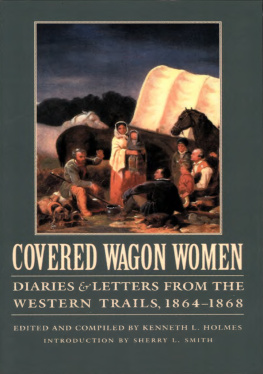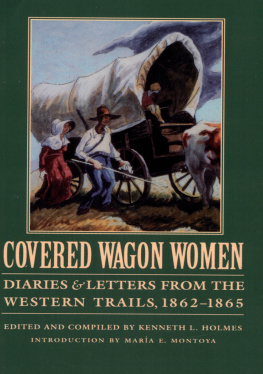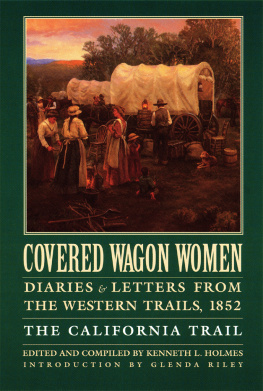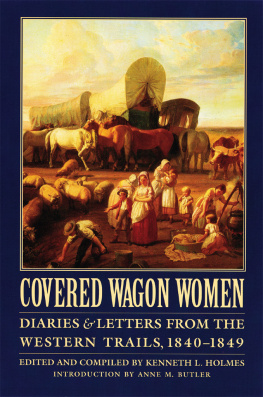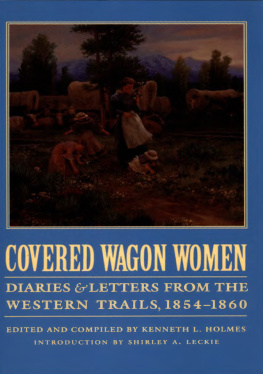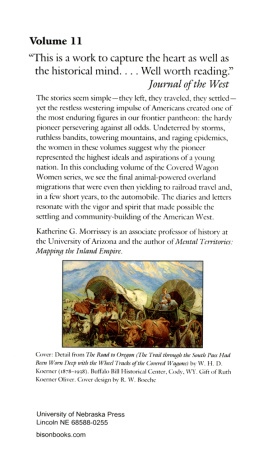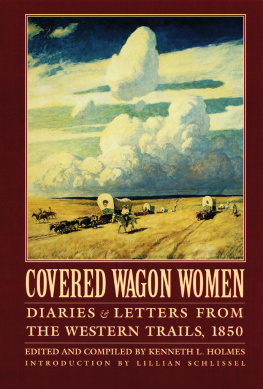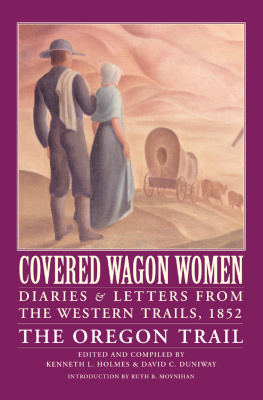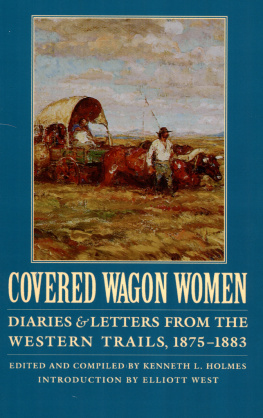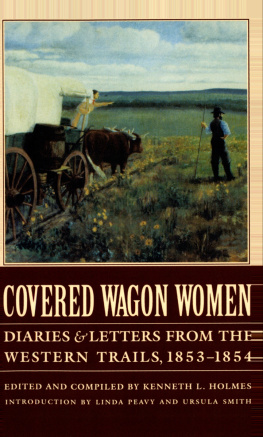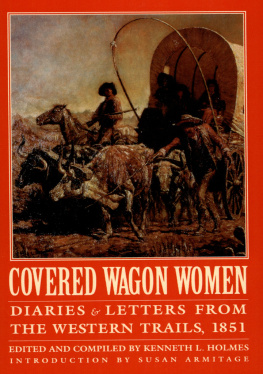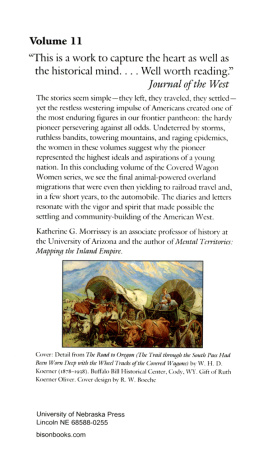Kenneth L. Holmes - Covered Wagon Women, Volume 9
Here you can read online Kenneth L. Holmes - Covered Wagon Women, Volume 9 full text of the book (entire story) in english for free. Download pdf and epub, get meaning, cover and reviews about this ebook. year: 2014, publisher: Bison Books, genre: Home and family. Description of the work, (preface) as well as reviews are available. Best literature library LitArk.com created for fans of good reading and offers a wide selection of genres:
Romance novel
Science fiction
Adventure
Detective
Science
History
Home and family
Prose
Art
Politics
Computer
Non-fiction
Religion
Business
Children
Humor
Choose a favorite category and find really read worthwhile books. Enjoy immersion in the world of imagination, feel the emotions of the characters or learn something new for yourself, make an fascinating discovery.
- Book:Covered Wagon Women, Volume 9
- Author:
- Publisher:Bison Books
- Genre:
- Year:2014
- Rating:3 / 5
- Favourites:Add to favourites
- Your mark:
- 60
- 1
- 2
- 3
- 4
- 5
Covered Wagon Women, Volume 9: summary, description and annotation
We offer to read an annotation, description, summary or preface (depends on what the author of the book "Covered Wagon Women, Volume 9" wrote himself). If you haven't found the necessary information about the book — write in the comments, we will try to find it.
Covered Wagon Women, Volume 9 — read online for free the complete book (whole text) full work
Below is the text of the book, divided by pages. System saving the place of the last page read, allows you to conveniently read the book "Covered Wagon Women, Volume 9" online for free, without having to search again every time where you left off. Put a bookmark, and you can go to the page where you finished reading at any time.
Font size:
Interval:
Bookmark:


1990 by Kenneth L. Holmes. Reprinted by arrangement with the Arthur H. Clark Company.
Introduction to the Bison Books Edition 1999 by the University of Nebraska Press
All rights reserved
Library of Congress Cataloging-in-Publication Data
The Library of Congress has cataloged Vol. 1 as:
Covered wagon women: diaries & letters from the western trails, 18401849 / edited and compiled by Kenneth L. Holmes; introduction to the Bison Books edition by Anne M. Butler.
p. cm.
Originally published: Glendale, Calif: A. H. Clark Co., 1983.
Reprinted from volume one of the original eleven-volume edition
T.p. verso.
Volume 1.
Includes index.
ISBN 0-8032-7277-4 (pa: alk. paper)
ISBN-13: 978-0-8032-7477-8 (electronic: e-pub)
ISBN-13: 978-0-8032-7478-5 (electronic: e-mobi)
1. Women pioneersWest (U.S.)Biography. 2.West (U.S.)History. 3. West (U.S.)Biography. 4. Overland journeys to the Pacific. 5. Frontier and pioneer lifeWest (U.S.) I. Holmes, Kenneth L.
F591.C79 1996 978dc20 95-21200 CIP
Volume 2 introduction by Lilian Schlissel
ISBN 0-8032-7274-X (pa: alk. paper)
Volume 3 introduction by Susan Armitage
ISBN 0-8032-7287-1 (pa: alk. paper)
Volume 4 introduction by Glenda Riley
ISBN 0-8032-7291-X (pa: alk. paper)
Volume 5 introduction by Ruth B. Moynihan
ISBN 0-8032-7294-4 (pa: alk. paper)
Volume 6 introduction by Linda Peavy and Ursula Smith
ISBN 0-8032-7295-2 (pa: alk. paper)
Volume 7 introduction by Shirley A. Leckie
ISBN 0-8032-7296-0 (pa: alk. paper)
Volume 8 introduction by Mara E. Montoya
ISBN 0-8032-7297-9 (pa: alk. paper)
Volume 9 introduction by Sherry L. Smith
ISBN 978-0-8032-7298-9 (pa: alk. paper)
The pagination has not been changed and no material has been omitted in this Bison Books edition.
The publisher does not have any control over and does not assume any responsibility for author or third-party websites or their content.
Introduction to the Bison Books Edition
Sherry L. Smith
A diary is an intensely personal document, an individual souls daily rendering of events and emotions. Most diarists expect no one, with the possible exception of family members, will ever read the words they put to page. Such thoughts are for private rather than public purpose. Yet, if that diary survives over time and if it is linked to a migration as momentous as the European-American sweep across the North American continent, it becomes the source and substance of history itself. It becomes a public account whose value transcends the individual life that shaped it. It becomes a communal document, which provides insight into the writers time, place and historical context.
What a time 186468 was in this nations history. The diarists presented in this volume lived through and, in some cases, participated in three of their centurys most momentous eventsalthough they rarely made an explicit connection between their individual actions and the broader context. And who could blame them? How many of us pause at the end of the day to connect our commonplace toil to historical context? Yet it is in making those linkages that these womens diaries hold, in part, their interest and value for historians.
First, of course, these women and their families took part in perhaps the most quintessential American experience: migration. Of course this was not simply a nineteenth-century affair. For millennia, people had been moving into and around the American continents. Long before Europeans stumbled upon the Western Hemisphere in 1492, the ancestors of Native Americans walked the land, seeking havens to establish homes, raise families, or find security. Although the pace would pick up when Europeans entered the picture, the essential pattern of movement, dynamism, and change was already in place.
The European newcomers did not understand this, of course. They presumed momentum was solely theirs and that Native Americans existed in a time warp, of sortsoutside of historical processes. Indians, according to nineteenth-century common knowledge, were changeless, not only incapable of a past but also of a future. It would have come as a surprise to the women whose works are offered here to see themselves presented as an extension of Indian behavior patterns. Nevertheless, they were.
Connections to European migration and immigration would have been easier for the women to make. By the time they climbed into their covered wagons, the land that had become the United States had witnessed over four centuries of such activity. Most of their predecessors departed from European and African shores, but others came from Pacific Islands, China, and other Asian points of embarkation. And once in the New World, the immigrants did not necessarily stay put. African slaves had little control over their destinies or destinations. As human beings transformed into commodities, they found no respite or security in the marketplace of flesh. Immigrants from Europe and Asia exhibited greater freedom to move and move again, to search out the best chance for themselves and their descendants.
New generations, in turn, took up the standard, linking movement with opportunity, penetrating into, or at least across, the heart of the continent as the years passed. By the 1860s such migration was commonplace. In fact, the reader who looks to these diaries for insight into why these women and their families moved will find no explicit explanations. It is as if the answer is too obvious, the motive too routine to require articulation. Still, the journey across the nations wide expanses was not so ordinary as to remain unrecorded. The womens journals reveal, in fact, the extraordinary stamina and fortitude, both physical and emotional, such treks demanded of participants.
They also demonstrate the family networks which proved so crucial to a successful migration experience. Far from operating alone, families reached out to one another across wide distances, as they had for centuries, encouraging the initial move and providing a warm and welcoming hearth once their emigrant relatives arrived at their shared destination. Nineteenth-century Americans may have venerated the individual, but they mostly operated in the context of family, group and community.
While the womens journeys coincided with the ongoing American saga of migration, their experiences also corresponded with another powerful theme of their centurythe transfer of dominance over the Great Plains from Indians to Americans. This tale climaxed in the 1860s when, as historian Elliott West put it, two cultures acted out two compelling visions in a land that could support only one.
By the 1860s some Native Americans and Anglo-Americans resorted to warfare, raiding, and violence as the conflict over control neared its end. Several of the women whose diaries are presented here walked right intoand throughwhat became for Plains Indians a life-or-death struggle over their way of life. And although several diarists noted the occasional burned-out ranch or stage stop in northeastern Colorado (part of Cheyenne reaction in the wake of 1864 Sand Creek Massacre) and expressed anxiety about their own safety, here too they failed to make the connection between their individual actions and the larger picture.
Of course, none of these women intended to plant her family on the Plains. Their destinies rested at the far edge of the continent: California, Oregon, or Idaho. They were, after all, just passing through. Yet even transitory passage carried an environmental price, as horses and other stock consumed precious grasses. More significantly, trailing across this mid-section portended final capitulation of the entire geographical space to United States jurisdiction. Nation building came later to the center, the jumped over area, but it came nonetheless. Perhaps nothing better symbolized this than the completion of the first transcontinental railroad in 1868, the year of the last diary printed here. The late 1860s, in fact, not only doomed the Plains Indians hegemony over the region but also signaled the beginning of the end for covered wagon travel itself. Modernization took many forms, but none more symbolically significant than the locomotive engine chugging across the West. Some westward moving families continued to carry their belongings in wagons into the twentieth century, but the future rested firmly in the power and promise of the railroad.
Next pageFont size:
Interval:
Bookmark:
Similar books «Covered Wagon Women, Volume 9»
Look at similar books to Covered Wagon Women, Volume 9. We have selected literature similar in name and meaning in the hope of providing readers with more options to find new, interesting, not yet read works.
Discussion, reviews of the book Covered Wagon Women, Volume 9 and just readers' own opinions. Leave your comments, write what you think about the work, its meaning or the main characters. Specify what exactly you liked and what you didn't like, and why you think so.

